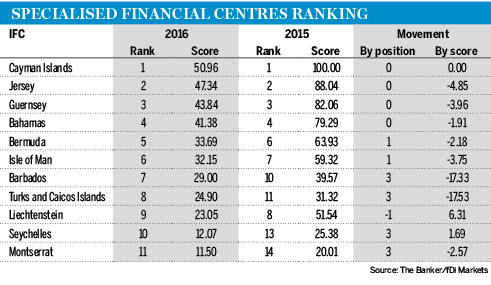Ever since the UK voted to separate from the EU in June this year, forecasts on the British economy have turned a dark shade of grey and many London-based international banks are reported to be considering moving operations elsewhere in Europe. However, very few professionals doubt that London still has a bright future as a financial centre – although uncertainty reigns over what type of success that might be, whether driven by a Brexit-induced low-tax environment or because of the intrinsic appeal of the UK’s business community, the country's widely respected legal system or its convenient geographical location.
While the UK wrestles with the various divorce options at its disposal before formalising its voters’ wish, The Banker’s ranking of international financial centres (IFCs) confirms London’s current world lead.
London outshone its rivals particularly when looking at the size of its financial services cluster, which is measured by the number of foreign direct investment (FDI) projects, the presence of heavyweight banks and the number of financial services companies based there, among other factors. A total of 739 FDI projects originated in London and reached other financial centres between 2010 and 2015, for an estimated capital expenditure of $24.83bn, according to greenfield investment monitor fDi Markets. Meanwhile the inward projects tally is 304, worth an estimated $8.88bn.
There are nine lenders headquartered in London ranked within The Banker’s 2016 Top 1000 World Banks ranking, together displaying $6008bn-worth of assets, while the number of firms in London’s financial services sector is a striking 47,977, according to data provider Dun and Bradstreet.
New York's old charm
In second place, New York continues to impress by the size of its stock exchanges and the depth of its capital markets as a whole. Furthermore, the largest New York-headquartered lenders – the 10 banks included in The Banker's Top 1000 ranking – closed 2015 with an impressive $85.4bn in pre-tax profits. This compares with London’s $24.2bn.
Hong Kong climbed one place to third position, followed by Singapore and Tokyo. Asian hubs have continued to perform well, with the most progress displayed by Chinese IFCs. Shanghai, China’s leading centre, has jumped to ninth place from 16th in the 2015 ranking thanks mostly to the growth and activity of its stock market, while 17th placed Beijing has also marginally improved its standing. Shenzhen, the ranking’s fastest riser, has jumped 14 positions to 34th, also on the back of the large volumes traded on its stock exchange.
In Latin America, São Paulo remains the largest IFC, in 47th place followed by Panama City, in 50th. The Panama Papers data leaks may have hit the Central American hub's reputation, but strong economic growth, a well-run economy and a relatively agile business environment have served Panama City’s financial centre well.
The specialised IFC list is once again led by the Cayman Islands, followed by Jersey and Guernsey.
Methodology
The Banker’s ranking of IFCs is based on data ranging from financial markets indicators to economic potential to business environment factors. A total of 82 indicators have been used in our analysis.
The ranking focuses on the level of international business and the value offered to institutions seeking to expand their international operations. In recognition of the fact that data for specialised financial centres is seldom consistent with that for mainland financial centres, The Banker has surveyed each specialised IFC and has compiled a separate table using information relevant to these locations. Publicly available data sources were used as well as The Banker Database and fDi Markets.








